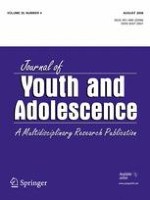01-08-2006 | Original Paper
Same-sex attraction and successful adolescent development
Gepubliceerd in: Journal of Youth and Adolescence | Uitgave 4/2006
Log in om toegang te krijgenAbstract
This study investigated the relation of adolescent same-sex attraction to “successful development” (Baltes, P. B., Am. Psychol. 32:366–380, 1997). Based on a survey of high-school adolescents, four groups were defined according to the nature of self-reported sexual attraction: exclusively heterosexual (EHA; n=3594); mostly heterosexual (MHA; n=124); bisexual (BSA; n=122); and same-sex attraction (SSA, n=36). Groups were compared across multiple intrapersonal, interpersonal, and environmental domains based on mean group differences and prevalence of developmental assets. Although the EHA group reported the most positive status across domains, several similarities among the groups were noted. Groups did not differ significantly in friendship quality and perceptions of school climate in the mean group comparisons, as well as academic orientation and (low) peer victimization in the assets-based analyses. Implications for successful development among adolescents reporting same-sex attraction are discussed along with the integration of the study of non-heterosexual youth into mainstream adolescent research.
